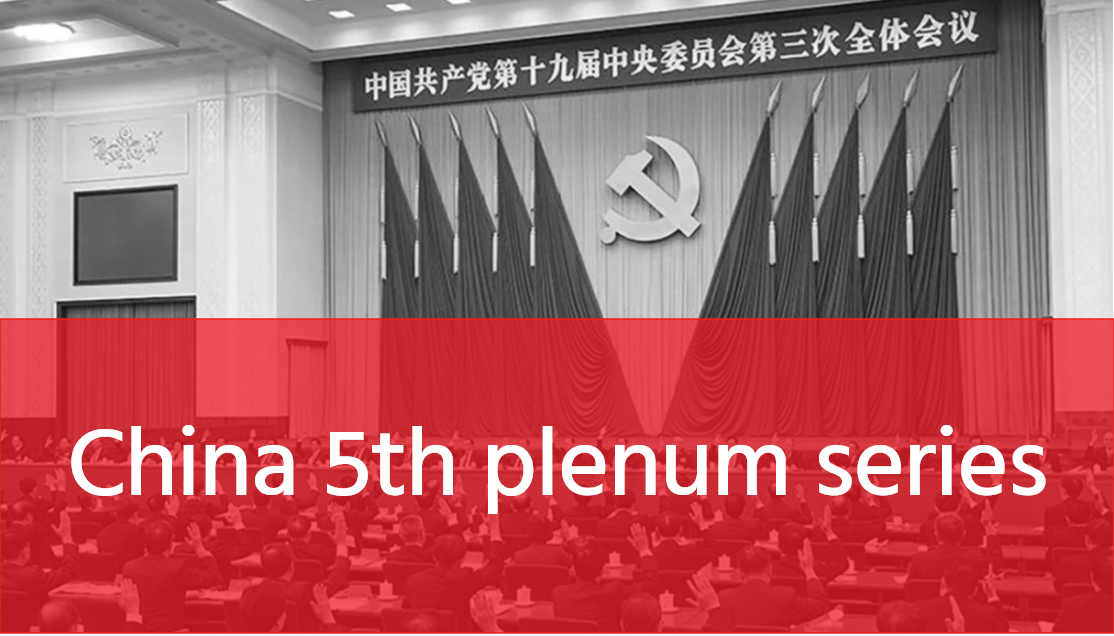Published 30 October 2020 | 5 minute read
One of the key takeaways of China's fifth plenum is that domestic demand-led growth will become central policy as the country seeks to become a “moderately developed country”, and there will be a high degree of development policy continuity with earlier pronouncements.
The Fifth Plenum of the 19th Communist Party of China (CPC) Central Committee was held in Beijing from October 26 to 29, 2020. The session has approved the Central Committee's Proposal for Formulating the 14th five-year plan for National Economic and Social Development (2021-25) and the Communiqué of the Fifth Plenary Session of the 19th CPC Central Committee. What are the key takeaways?
Growth implicitly targeted at 5%
First of all, a GDP growth target, as expected, was not mentioned. Second, China's goal, by 2035, is to become a “moderately developed country”. Third, environmental protection is emphasized, again, as expected. In fact, in late September, President Xi pledged an emission peak before 2030 and to achieve carbon neutrality by 2060. GDP growth targets are always closely watched because other targets are less quantifiable. Moreover, GDP growth targets are about policy responses as they imply the magnitude of fiscal stimulus. In recent years, GDP growth has been hovering around 6%. So the issue is really whether a sustainable economic growth rate could be maintained without taking on too much debt. Is the GDP growth rate, therefore, implicitly targeted around 5%? 2020 has seen a dramatic V-shaped recovery on the back of a swift resumption of business since March and a well-calibrated fiscal stimulus. It is almost certain that the Q4 growth rate will be higher than the 4.9% YoY in Q3. The fact that Liu He, Vice Premier, has recently proclaimed that China's economic growth in 2020 would be positive, a gesture to downplay China's strong recovery, has underscored policymakers' confidence in the state of the economy. In 2021, growth could easily be above 7% simply because of the base effect (Q1 and Q2 of 2020 saw -6.8% YoY and 3.2% YoY respectively). It is also safe to assume that the global economic outlook in 2021 will be more favorable regardless of progress in the development of a vaccine. As such, China could and should shift focus to social welfare and poverty reduction.
How to define “moderately developed”?
What is the definition of a “moderately developed country”? Based on what the Chinese government has elaborated on various occasions, it indicates a more balanced approach to growth underpinned by endogenous forces, environmental protection and much improved income distribution. Notwithstanding the fact that policymakers have de-emphasized the GDP growth target, in our view, 4%-5% would be perceived as the lower bound for the next ten years. By extrapolating such a growth trajectory, a moderately developed country would imply that China wants to achieve GDP per capita of roughly US$20,000 by 2035. How to achieve this goal? In the communique, “dual circulation” is defined as the core strategy against the backdrop of a possibly challenging external environment which could be characterized as geopolitical flashpoints, heightened distrust between nations in the post-Covid world, rivalry between the US and China, and investment trade-offs between efficiency and resiliency for global companies. This challenging external environment has made unlocking domestic demand a much higher priority than otherwise. However, given China's high dependency on global energy and commodities, reliance on massive import substitution would not be feasible. That is why China wants to stay open.
Policy continuity
The key goals from the fifth plenum of the 18th CPC Central, which took place exactly five years ago, show policy continuity. They were:
- Upgrade manufacturing and promote advanced industries
- Significantly increase the contribution of consumption in economic growth
- Accelerate urbanization
- Achieve significant progress in agricultural modernization
- Raise living standards and the quality of life
- Eliminate rural and regional poverty and rehabilitate all poor counties
- Improve citizens' moral integrity and promote cultural progress
- Improve environmental protection
We should expect a de-emphasis of GDP growth and a continuing emphasis on environmental protection and income distribution to be the long-term objectives as China aims to achieve moderately developed country status in the next 15 years.
***
About the author and Deloitte China
Sitao Xu is Chief Economist and Partner at Deloitte China. Deloitte China delivers a comprehensive range of audit & assurance, consulting, financial advisory, risk advisory and tax services to local, multinational and growth enterprise clients in China.
© The Hinrich Foundation. See our website Terms and conditions for our copyright and reprint policy. All statements of fact and the views, conclusions and recommendations expressed in this publication are the sole responsibility of the author(s).







